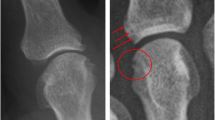Abstract:
Our objective was to assess the progression of osteoarthritis (OA) using scoring systems based on the anatomical changes recorded in the finger joints on standard radiographs and to test how far these scoring systems could be used to evaluate the effects of candidate ‘disease modifying osteoarthritis drugs’ (DMOAD). The appearance and growth of osteophytes, narrowing of the joint space and subchondral bone changes allowed the classic OA-associated anatomical lesions to be used to score the progression of finger joint OA. Progression of OA in the finger joints was also assessed by the their evolution through previously described and predictable anatomical phases on standard X-rays. These phases were characterised by complete loss of the joint space preceding or coinciding with the appearance of subchondral cysts eroding the entire subchondral plate, and have been described in ‘inflammatory’ or ‘erosive’ OA. The erosive episodes were followed by processes of remodelling. In order to interfere with the progression of osteoarthritis, two chondroitin sulphates with possible DMOAD effects were used in two series of patients with OA of the finger joints. The patients were included in two separate randomised, double-blind placebo-controlled trials: 46 of them received chondroitin polysulphate and 34 received chondroitin sulphate. Eighty-five patients were kept on placebo medication and were used as controls. All 165 patients were followed for 3 years. Posteroanterior X-rays of the metacarpophalangeal and interphalangeal (IP) finger joints were obtained at the start of this prospective study and at yearly intervals thereafter. Almost 80% of the distal IP and 50% of the proximal IP were affected at study entry. In approximately 40% of the patients the classic picture of OA of the IP joints was complicated by manifest erosive OA changes. The two systems to score the progression of OA (Anatomical Lesion and Anatomical Phase Progression Score System) showed definite progression within 3 years of follow-up, especially in the IP joints. When compared with the placebo controls, none of the chondroitin sulphates prevented OA from occurring in previously normal finger joints. However, when the classic OA-associated anatomical lesions were considered, OA was less progressive in both active treatment groups. Furthermore, fewer patients from both chondroitin sulphate- and chondroitin polysulphate-treated groups developed ‘erosive’ osteoarthritis. In conclusion, conventional radiographs can be used to assess the morbidity and progression of hand OA. The systems used to score the progression of finger joint OA allowed the DMOAD effects of both chondroitin sulphates to be evaluated. The data recorded during these pilot studies should help investigators to design future long-term clinical experiments.
Similar content being viewed by others
Author information
Authors and Affiliations
Additional information
Received: 23 July 2001 / Accepted: 12 December 2001
Rights and permissions
About this article
Cite this article
Verbruggen, G., Goemaere, S. & Veys, E. Systems to Assess the Progression of Finger Joint Osteoarthritis and the Effects of Disease Modifying Osteoarthritis Drugs. Clin Rheumatol 21, 231–243 (2002). https://doi.org/10.1007/s10067-002-8290-7
Published:
Issue Date:
DOI: https://doi.org/10.1007/s10067-002-8290-7




